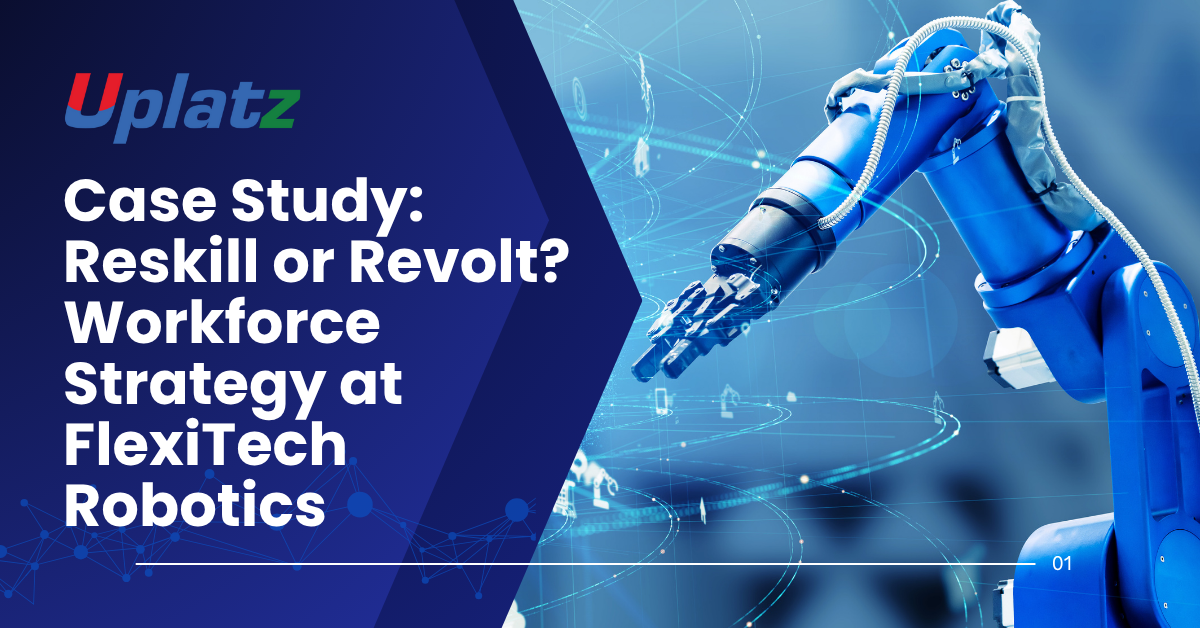📘 Case Study:
“Reskill or Revolt? Workforce Strategy at FlexiTech Robotics”
Company Background
FlexiTech Robotics, founded in 2009 in Eindhoven, Netherlands, is a leading European manufacturer of smart automation systems used in logistics, warehousing, and light manufacturing. The company designs robotic arms, warehouse navigation bots, and AI-powered vision systems for major clients such as DHL, IKEA, and Carrefour.
As of 2024, FlexiTech employs 2,100 people across 4 European plants, with 750 floor-level workers involved in assembly, logistics, testing, and packaging.

Discover how to track and improve website performance: Click to view course
Strategic Shift
In 2025, FlexiTech announces a €70 million digital transformation initiative—Project Phoenix—to implement:
- Fully automated assembly lines
- IoT-enabled predictive maintenance systems
- Generative AI tools for robotic vision calibration
- A centralized control tower for operations across all plants
This automation wave is expected to:
- Eliminate ~400 operational roles by 2027
- Create ~120 new technical jobs (robotics maintenance, AI oversight)
- Reduce time-to-market by 28%
- Improve product quality and predictive downtime by 40%
Workforce Reality
While leadership frames this as a “future-ready transformation,” internal surveys show:
- 63% of plant workers feel anxious about job security
- 48% of workers over age 40 doubt their ability to “retrain for tech roles”
- Union leaders have requested formal reassurances, transparency, and retraining budgets
- A pilot retraining program in 2024 saw only 19% voluntary enrollment, citing fear, lack of clarity, and skepticism
Leadership Dilemma
CHRO Sofia Berends must present a comprehensive workforce transition strategy to the board, aligned with four goals:
- Upskill 300+ floor workers by 2027
- Avoid large-scale attrition or reputational fallout
- Support cultural adaptation to human-machine collaboration
- Maintain production output during transformation
Strategic Options Being Considered
Option A: Tech Academy + Certifications
Launch an internal “FlexiTech Future Academy” with modular training in robotics, automation tech, and data literacy. Offer certification pathways in partnership with local technical colleges.
Option B: Career Bridge Program
Create guaranteed internal pathways for eligible workers to transition into supervisory, maintenance, or QA roles with step-by-step support and mentorship.
Option C: Voluntary Exit + Social Package
Offer generous early retirement and voluntary separation packages to those uninterested in retraining. Complement with job placement support outside FlexiTech.
Option D: Union-Backed Co-Creation
Involve union reps and plant leaders in designing and governing the transition roadmap. Tie retraining success to performance bonuses for shop-floor teams.
Key HR & Business Metrics (2024)
| Metric | Value |
| Attrition Rate (Annual) | 8.5% |
| Avg. Age of Plant Worker | 43.2 years |
| Avg. Training Spend per Worker | €480 |
| Production Downtime (monthly) | 3.2 hours/plant |
| Employee Satisfaction Score | 68/100 |
| Number of Unions Represented | 3 |
🔍 Student Discussion Questions
Human Capital & Reskilling
- What barriers (psychological, logistical, strategic) are preventing reskilling uptake? How can FlexiTech increase participation?
- Which option(s) from A–D offer the best chance of upskilling success without alienating the workforce?
- Should FlexiTech make retraining mandatory, incentivized, or purely voluntary?
Organizational Change Management
- What leadership styles and communication strategies are most appropriate during automation-led transformation?
- How can FlexiTech address the intergenerational divide in tech adoption and upskilling confidence?
- What metrics should be used to track the success of the transformation from a people perspective?
Ethics, Culture & Social License
- What ethical responsibilities does FlexiTech have to long-serving employees during automation?
- How can FlexiTech maintain trust with unions and society while transitioning to a high-tech future?
- What long-term culture shifts are needed to foster human-machine collaboration as “normal”?
Strategic Trade-Offs
- If Sofia had to present a 3-year workforce transformation roadmap, what would it include—and how would she balance cost, continuity, and culture?
